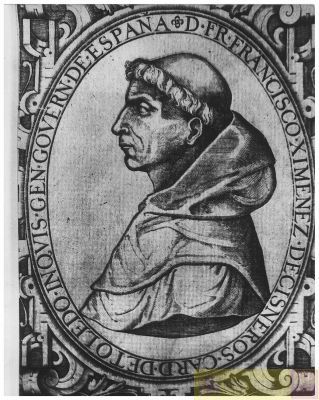 Persona - Francisco Jiménez de Cisneros (1436-1517, OFM)
Persona - Francisco Jiménez de Cisneros (1436-1517, OFM)
Identificación
Tipo:
Persona
Forma autorizada:
Francisco Jiménez de Cisneros (1436-1517, OFM)Otras formas
Fechas de existencia:
Torrelaguna (Madrid, España) 1436 - Roa (Burgos, España) 1517-11-08
Historia:
Religioso español. Arzobispo de Toledo, Regente de Castilla.
Nacido en Torrelaguna (Madrid), en el seno de una familia noble. Cursó estudios de Teología y Derecho en las Universidades de Salamanca y Roma. Inició su carrera Sacerdotal como Arcipreste de Uceda y Vicario General y Provisor de la Diócesis de Sigüenza y más adelante, guardián y Superior del Convento de la Salceda, tras ingresar en la orden Franciscana en 1484. Fue provincial del Convento Franciscano de San Juán de los Reyes (Toledo), donde cambió su verdadero nombre, Gonzalo, por el de Francisco.
Isabel I la Católica, le nombró su confesor y su principal consejero. En 1495, le propuso y encumbró a la sede de Toledo, como Dignidad Arzobispal, desde la cuál, trató de corregir las desviadas costumbres del clero secular. En 1499, acompañó a los Reyes Católicos (Isabel y Fernando) a Granada. Emprendió la conversión forzosa y los bautismos masivos. Así, en 1502, se ordenaba la expulsión de toda la población musulmana, no convertida. Financió y hasta dirigió personalmente expediciones a la zona berberisca, logrando apoderarse de Orán (1509), Bugía y Trípoli. Militarmente, también destacó por sus intentos de creación de una milicia activa, llamada "gente de ordenanza" y por la reorganización de "los lansquenetes" alemanes. También desarrolló labor de mecenazgo humanista, que cristalizó en la fundación de la Universidad de Alcalá de Henares en 1508, y en la impresión de la famosa Biblia Políglota Complutense (1517). Recibió el Capelo Cardenalicio en 1507, a instancias de Fernando el Católico, quien también, le nombró Inquisidor General, en esa misma fecha. Fue albacea testamentario de la reina Isabel y miembro de la Regencia provisional nombrada a la muerte de Felipe I el Hermoso en 1506 (los miembros de la grandeza le nombraron Gobernador General del reino).
Fue uno de los artífices de la vuelta, en 1507, de Fernando el Católico como rey de Castilla, que en 1516 le nombró en su testamento regente y Gobernador de Castilla, León, Granada y Navarra, hasta la llegada de su nieto Carlos de Gante, quien llegaría a ser el rey Carlos I. Aplacó los conatos de revuelta de la nobleza castellana y del partido flamenco, contra el futuro emperador. Falleció en Roa (Burgos).
Ocupaciones
(Función) Desempeña/lleva a cabo/realiza:
Lugares
Lugar de Nacimiento:
Lugar de Defunción:
Conceptos/Objetos/Acontecimientos
Fuentes
Relaciones
Relaciones asociativas :
Relaciones temporales :
Relaciones familiares :






